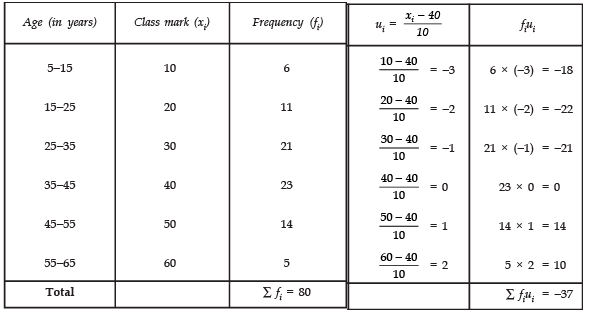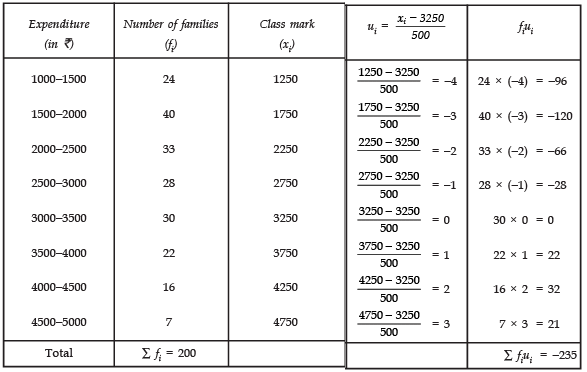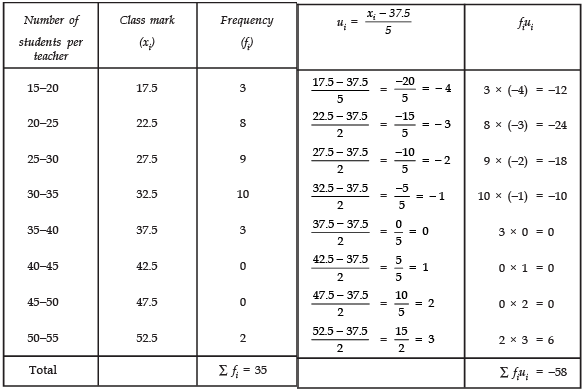NCERT Solutions for Class 10 Maths Chapter 13 - Statistics (Exercise 13.2)
Q1: The following table shows the ages of the patients admitted in a hospital during a year:
Find the mode and the mean of the data given above. Compare and interpret the two measures of central tendency.
Sol: Mode:
Here, the highest frequency is 23.
The frequency 23 corresponds to the class interval 35 − 45.
∴ The modal class is 35 − 45
Now, Class size (h) = 10
Lower limit (l) = 35 Frequency of the modal class (f1) = 23
Frequency of the class preceding the modal class f0 = 21
Frequency of the class succeeding the modal class f2 = 14
Mean
Let assumed mean a = 40
∵ h = 10

∴ Required mean = 35.37 years.
Q2: The following data gives the information on the observed lifetimes (in hours) of 225 electrical components:
Determine the modal lifetimes of the components.
Sol: Here, the highest frequency = 61.
∵ The frequency 61 corresponds to class 60 − 80
∴ The modal class = 60 − 80
∴ We have: l = 60
h = 20
f1 = 61
f0 = 52
f2 = 38
Thus, the required modal life times of the components are 65.625 hours.
Q3: The following data gives the distribution of total monthly household expenditure of 200 families of a village. Find the modal monthly expenditure of the families. Also, find the mean monthly expenditure:
Sol: Mode:
∵ The maximum number of families 40 have their total monthly expenditure is in interval 1500−2000.
∴ Modal class is 1500−2000.
l = 1500, h = 500
f1 = 40, f0 = 24
f2 = 33
Thus, the required modal monthly expenditure of the families is Rs 1847.83.
Mean: Let assumed mean (a) = 3250
∵ h = 500
∴ We have the following table:
Thus, the mean monthly expenditure = Rs 2662.50.
Q4: The following distribution gives the state-wise teacher-student ratio in higher secondary schools of India. Find the mode and mean of this data. Interpret the two measures.
Sol: Mode:
Since the class 30 − 35 has the greatest frequency and h = 5
l = 30
f1 = 10
f0 = 9
f2 = 3
Mean:
Let the assumed mean (a) = 37.5
Since, h = 5
∴ We have the following table:
Thus ,the required mean is 29.2
Q5: The given distribution shows the number of runs scored by some top batsmen of the world in one-day international cricket matches.
Find the mode of the data.
Sol: The class 4000−5000 has the highest frequency i.e., 18
∴ h = 1000
l = 4000
f1 = 18
f0 = 4
f2 = 9
Now,
Thus, the required mode is 4608.7.
Q6: A student noted the number of cars passing through a spot on a road for 100 periods each of 3 minutes and summarised it in the table given below. Find the mode of the data:
Sol: ∵ The class 40 − 50 has the maximum frequency i.e., 20
∴ f1 = 20,
f0 = 12,
f2 = 11 and h = 10
Also
l = 40
= 40 + 4.7 = 44.7
Thus, the required mode is 44.7
|
70 videos|242 docs|187 tests
|
FAQs on NCERT Solutions for Class 10 Maths Chapter 13 - Statistics (Exercise 13.2)
| 1. What is the importance of statistics in our daily lives? |  |
| 2. How is statistics used in the field of economics? |  |
| 3. What are the different types of data in statistics? |  |
| 4. How can statistics be used in the field of education? |  |
| 5. What is the difference between descriptive and inferential statistics? |  |

















